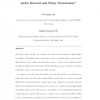Free Online Productivity Tools
i2Speak
i2Symbol
i2OCR
iTex2Img
iWeb2Print
iWeb2Shot
i2Type
iPdf2Split
iPdf2Merge
i2Bopomofo
i2Arabic
i2Style
i2Image
i2PDF
iLatex2Rtf
Sci2ools
JCSS
2010
2010
Fast convolution and Fast Fourier Transform under interval and fuzzy uncertainty
Convolution y(t) = a(t − s) · x(s) ds is one of the main techniques in digital signal processing. A straightforward computation of the convolution y(t) requires O(n2) steps, where n is the number of observations x(t0), . . . , x(tn−1). It is well known that by using the Fast Fourier Transform (FFT) algorithm, we can compute convolution much faster, with computation time O(n · log(n)). In practice, we only know the signal x(t) and the function a(t) with uncertainty. Sometimes, we know them with interval uncertainty, i.e., we know intervals [x(t), x(t)] and [a(t), a(t)] that contain the actual (unknown) functions x(t) and a(t). In such situations, it is desirable, for every t, to compute the range [y(t), y(t)] of possible values of y(t). Of course, it is possible to use straightforward interval computations to compute this range, i.e., replace every computational step in FFT by the corresponding operations of interval arithmetic. However, the resulting enPreprint submitted to Else...
Computations | Compute | Convolution | JCSS 2010 |
| Added | 28 Jan 2011 |
| Updated | 28 Jan 2011 |
| Type | Journal |
| Year | 2010 |
| Where | JCSS |
| Authors | Guoqing Liu, Vladik Kreinovich |
Comments (0)

